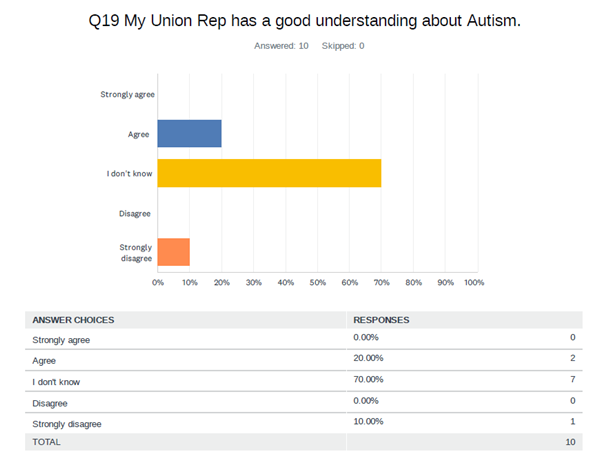
Welcome back to Taking Fair Work Forward – a learning course on emerging issues, for EIS equality rep. In this course, we wanted to link in key learning on equality issues, with current matters affecting education.
A lay of the land
A key strength of trade unions is the ability to join members’ voices together. Oftentimes, we know that the experiences of members who face inequality, are likely to be siloed or treated as individual issues by employers. When it comes to long-Covid, this may mean that the full extent of the issue is unknown, and our ability to organise around the issue, is impacted.
Last week, we looked at gathering anonymous information in meetings. Through the use of surveys, we can achieve an even fuller picture of members’ views on important topics and shed light on their experiences. Survey data can powerfully illustrate the extent of an issue, and through the use of open-ended questions, examples can provide life to quantitative data, too.
In this learning, we will consider how to create short, impactful surveys with findings that can be used in workplace organising and employer negotiations. You can create your own SurveyMonkey account and create a draft survey related to the topic of reasonable adjustments. Your fellow Fair Work Forward Equality Reps will be your participants and test out your survey, so remember to post the link on the Padlet, and respond to others’ surveys, too!
Surveys can be very helpful in gathering the views and perspectives of members who are less likely to be engaged in trade union activism already. For disabled members, or members who suffer from long-Covid, being able to contribute a viewpoint without this being an onerous task, is important.
Achieving the right engagement for a survey can be challenging. Generally, it helps to have clear communication that stipulates the purpose of the survey and what results will be used for. Explaining the benefits and importance of every single person completing the survey (and being realistic about the expected time it will take) will help you get the best results.
Also, remember to be transparent about whether the survey is anonymous or whether there will be some identifying elements included (such as matching geographical location to a protected characteristic and finding that there is only 1 disabled person in X Council area, will easily identify that person).
Identifying the purpose or topic of the survey is the most important first step as this will inform the entirety of the process thereafter. Picking your timing can also be essential to the success of your survey – when are people most likely to engage, or see your communication? Is it a hot topic that people are likely to engage in just now?
Reflective question
Determining your sample
Your sample will depend on the purpose of your survey. If you are looking for your survey to have statistical relevance, you may want to aim for a percentage of your population (for example your membership) and ensure that you have a matching demographic spread in responses.
This is not always necessary, however, as it can be equally valuable to delve deeper into the experiences of a limited sample, to better understand their needs. For example, surveying only a few members who have had experience of long-Covid will give invaluable insight into this and can help improve processes accordingly. Though not a representative sample, such findings can point us in the right direction.

That is the question
For surveys, it can be helpful to have a balance of closed-ended questions, which can more easily be compared to others, and open-ended questions, which can illustrate your findings and give examples. A close ended question could be: “Do you have experience requesting a reasonable adjustment?” and an open-ended question could be: “What are some examples of reasonable adjustments that you have experience of?”
It will be important to avoid your questions being leading and open to interpretation, for example asking: “How long have you suffered at home with long-Covid?”. Phrased this way, respondents can interpret the question in many different ways (being unwell at home), and it makes a lot of assumptions (that they have long-Covid, and that they are suffering).
Questions should be clear and easy to understand, concise and to the point, and directly aimed at meeting your objective and purpose.
Remember to always include a few demographic questions if your sample size is big enough that individuals cannot be identified, as this will help you identify trends across protected characteristics.
If you do not yourself have lived experience of the equality-related topic you are investigating, it may be helpful to ask someone who do, to look over your questions. This can help in making sure they are relevant to the sample you are trying to reach and that they are worded appropriately.
Analysing your results
SurveyMonkey helpfully gathers results to your survey in real-time. Through the analysis tools you can make comparisons and pull out visuals that can help illustrate your points.
You can also see whether you are happy with your sample, or whether you require more responses from a particular group, who you may be able to reach out to directly.
When reporting your results, remember to include information about how many people answered each particular question, as some participants will choose to skip questions.
View our archived material on Fair-Work within Scotland’s education system